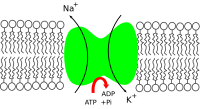
Photo from wikipedia
OBJECTIVE The aim of this study was to explore the association between sodium intake, as assessed by 24-h urinary sodium excretion, and various obesity parameters among South Korean adults. The… Click to show full abstract
OBJECTIVE The aim of this study was to explore the association between sodium intake, as assessed by 24-h urinary sodium excretion, and various obesity parameters among South Korean adults. The associations of 24-h urinary sodium excretion and sodium intake calculated from the dietary questionnaire with obesity parameters also were compared. METHODS This multicenter, cross-sectional study analyzed data of 640 healthy adults from eight provinces in South Korea. Obesity was assessed by body mass index (BMI), waist circumference (WC), waist-to-hip ratio (WHR), and waist-to-height ratio (WHtR). Mean 24-h urinary sodium excretion was calculated from repeatedly collected 24-h urine samples. Participants' dietary intake was assessed by 24-h dietary recall interview on the days before 24-h urine collection. RESULTS In both sexes, the means of all anthropometric measurements tended to increase proportionally with 24-h urinary sodium excretion quartiles, regardless of adjustment. Men in the highest quartile (Q4) of 24-h urinary sodium excretion had increased odds of obesity (as assessed by BMI, WC, WHR, and WHtR) compared with men in the three lower quartiles (Q1-Q3) of 24-h urinary sodium excretion. Women in Q4 of 24-h urinary sodium excretion exhibited a higher chance of general obesity and abdominal obesity. Sodium intake calculated from the dietary questionnaire was not significantly associated with obesity in either sex. CONCLUSIONS In Korean adults, there was a positive association between higher sodium intake as assessed by 24-h urinary sodium excretion and obesity independent of energy intake.
Journal Title: Nutrition
Year Published: 2017
Link to full text (if available)
Share on Social Media: Sign Up to like & get
recommendations!